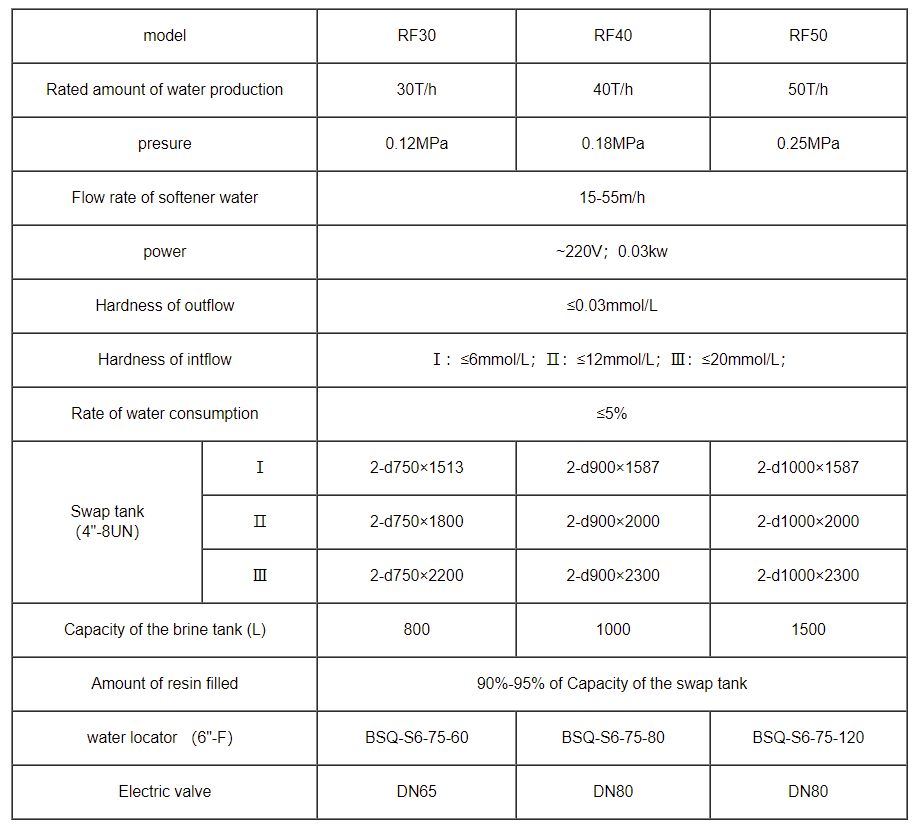目录
影响软水器再生持续时间的因素
软水器是许多家庭的必备电器,因为它们有助于去除水中的钙和镁等矿物质,这些矿物质可能会导致管道和电器中形成水垢。维护软水器的一个重要方面是再生过程,其中包括冲洗掉积累的矿物质并重新填充软水器罐中的树脂珠。此再生过程的持续时间可能会因多种因素而异。
影响软水器再生持续时间的关键因素之一是软化器罐的大小。较大的水箱具有更高的容量,并且在需要再生之前可以处理更多的水,这意味着再生过程可能需要更长的时间才能完成。另一方面,较小的水箱可能需要更频繁地再生,但过程本身可能会更快。

影响软水器再生持续时间的另一个因素是您所在地区的水硬度。硬水含有较高含量的矿物质,这会导致更频繁的再生循环。如果您居住在水质非常硬的地区,您的软水器可能需要更频繁地再生,这会增加完成该过程所需的总时间。
您拥有的软水器类型也会影响再生的持续时间。一些软水器配备了先进的技术,可以更有效地再生,从而减少完成该过程所需的总时间。另一方面,旧的或不太先进的模型可能需要更长的时间才能重新生成,特别是如果它们没有得到适当的维护。
| 型号 | AFC2-LCD | AFC2-LED |
| 工作岗位 | 过滤器-反洗1-反洗2- 快速冲洗- Filter | |
| Regeneration mode | Automatic | Automatic |
| Time by day :0-99days | Time by day :0-99days | |
| Time by hours:0-99 hours | Time by hours:0-99 hours | |
| In (inlet of valve) | 1/2”F | 1/2”F |
| I1(inlet of first filter) | 1/2”F | 1/2”F |
| I2(inlet of second filter) | 1/2”F | 1/2”F |
| Drain | 1/2”M | 1/2”M |
| D1( Drain of first filter) | 1/2”M | 1/2”M |
| D2(Drain of second filter) | 1/2”M | 1/2”M |
| Water capacity | 2m3/h | 2m3/h |
| Working pressure | 0.15-0.6Mpa | |
| Power Supply | AC100-240V/ 50-60Hz / DC12V-1.5A | |
In addition to these factors, the settings on your water softener can also impact the duration of regeneration. Most Water Softeners allow you to program regeneration cycles based on your household’s water usage patterns. If you have set your water softener to regenerate more frequently, the process may take longer to complete. Conversely, if you have set longer intervals between regeneration cycles, the process may be quicker.
It is important to note that the duration of water softener regeneration can vary from one model to another, so it is essential to consult the manufacturer’s instructions for specific information on how long the process should take. In general, however, most water softeners take anywhere from 60 to 120 minutes to complete a regeneration cycle.
In conclusion, several factors can affect the duration of water softener regeneration, including the size of the tank, the hardness of the water, the type of water softener, and the settings on the appliance. By understanding these factors and properly maintaining your water softener, you can ensure that the regeneration process is efficient and effective in keeping your water free from harmful Minerals.
Tips for Speeding Up Water Softener Regeneration Process
Water softeners are essential appliances in many households, as they help to remove minerals such as calcium and magnesium from water, which can cause limescale buildup in pipes and appliances. One important aspect of maintaining a water softener is the regeneration process, which involves flushing out the accumulated minerals and recharging the resin beads in the softener tank. The duration of the regeneration process can vary depending on the type and size of the water softener, as well as the hardness of the water in your area.
On average, a water softener regeneration cycle can take anywhere from 60 to 120 minutes to complete. However, there are several tips and tricks that you can use to speed up the regeneration process and ensure that your water softener is operating efficiently.
One of the most effective ways to speed up the regeneration process is to adjust the regeneration frequency and time settings on your water softener. Most modern water softeners come with programmable controls that allow you to customize the regeneration schedule based on your household’s water usage and hardness Levels. By setting the regeneration frequency to occur during off-peak hours when water usage is low, you can reduce the overall regeneration time and ensure that your water softener is ready to provide soft water when you need it most.
Another tip for speeding up the regeneration process is to use high-quality Salt pellets or Crystals in your water softener. The type of salt you use can have a significant impact on the efficiency of the regeneration process, as low-quality salt can leave behind residue and impurities that can clog the resin beads in the softener tank. By using pure salt pellets or crystals that are specifically designed for water softeners, you can help to ensure that the regeneration process is as effective and efficient as possible.
In addition to using high-quality salt, it is also important to regularly check and maintain your water softener to prevent any issues that could slow Down the regeneration process. This includes checking the salt levels in the brine tank, inspecting the resin beads for signs of damage or buildup, and cleaning the system regularly to remove any debris or sediment that could affect the performance of the water softener.
If you find that your water softener is taking longer than usual to complete the regeneration process, it may be a sign that there is a problem with the system that needs to be addressed. Common issues that can affect the regeneration process include clogged Valves, malfunctioning controls, or damaged resin beads. In these cases, it is best to contact a professional water softener technician to diagnose and repair the problem to ensure that your water softener is operating at peak efficiency.
By following these tips and taking proactive steps to maintain your water softener, you can help to ensure that the regeneration process is as quick and efficient as possible. With a properly functioning water softener, you can enjoy the benefits of soft water in your home and protect your appliances and plumbing from the damaging effects of hard water.
